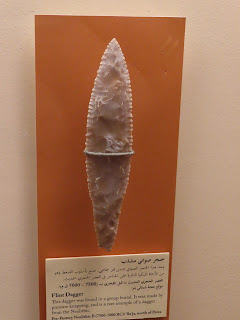This museum is large and it had all the right ingredients, local history, demographic data on the local population, ancient artifacts, treasures found nowhere else and interactive displays with take away items. So many items that spanned eons.
Our Uber driver dropped us off 500 feet before the museum at the City Hall.
It was cold and windy and so we poked around to see if this was the real place, it was not.
So off we walked and here was the City Hall from the back
Ahead the museum!
An old railroad car outside
Lets get inside, brrrrr
The rain has made the entire place wet and slippery
Appropriately with the weather the way it was, we see pipes and drainage systems used in Petra
Waterproof ceramics
The aqueduct and the angle of the water delivery system
Jordanians are acutely aware of being in a desert
A replica of a goats milk churn, 6000 years old!
The dead sea is shrinking because the water sources that had traditionally kept it fed with fresh water have all been diverted over the centuries
So to fix it there is a plan afoot for a Red Sea to the Dead Sea pipeline
A diagram of the Treasury building in Petra
The Egyptian influence was always here
The Kufiyyeh is the traditional Jordanian red and white scarf. The tassel size denoted wealth and status
This is the Pella Box from 1650 BCE
All the parts of the Jordanian Flag. Three colors for three different Caliphates and the seven pointed star for the seven first verses of the Quran
Demographics data on educational levels of the population
3600 BCE female figure and Queen's coins
Latin
Greek
Arabic
Nabataean
Safartic
Cuniform
The cylinder scroll rolled over the foil and we got this souvenir
At 9000 years old these are some of the oldest human form sculptures
Almost spooky
Anatomically correct
Oddly approachable
The oldest plaster ever found
Great carved stone
A great display of small arrowheads
A huge 6 inch or bigger dagger made of flint
After the buried skulls flesh decayed the bones would be recovered and plaster put on the skull to recreate the faces of their ancestors. They would then be placed in homes and return to the family
These statues were placed under the floors of long abandoned houses in specially dug pits. They all faces east to west
A petroglyph that was recovered and placed in this museum
It was missing some parts
I have never seen flint discs. There was a hole to attach to a handle or to a rope
An example of a pottery burial for infants
They were sealed in the jar
three different tribes and their traditional dress, Jerash, Krak and Adwan
Ma'am, Irbid and Ramtha
This is the Salt tribe. One normal size and one huge giant sized
A stretched leather box and horsehair string that was played with a bow
A very elaborate coffee making tradition. Three pots are used to boil and filter the coffee
A hanging pot
Bronze ax heads and the molds used to make them
A ceremonial ax head and hand
A big granite stele with Egyptian influences circa 1300 BCE
in 1868 this was discovered by a German Missionary and word got out. German, English and French teams came to snatch it and the Ottoman Authorities were running interference. It got so bad that the locals burned it and it broke into pieces!
This is the translation of the stele in which it says how many thousands of people the king killed
King Big Foot
Bob big head
Ceramic coffins
Duck Head handle
A ceramic cult stand
A time lime of alphabets
A chart showing the letters in six different languages
Egyptian Hieroglyphics, Proto Sinaitic, Phoenician, Aramaic, Nabataean, Ancient Arabic, Arabic
Owl. cat and bowl
Just in case we need to sign our names in Greek
Or in Aramaic
Gold!
Big jars on a big camel
A heavily laden camel
The figures represent different zodiac signs
A great mosaic
A bronze lyre
The Hellenistic period
While excavating Tal dur Alla they preserved these three distinct layers
Some of the finest clay was used in this area. It allowed for shapes and decorations unrivaled in all of ancient pottery making
The evolution of the designs
Horse oil lamp
Now we know where all the marble busts come from
A water wheel powered stone saw
The marble base of a column
Cupid is about to set some surgery!
The pots that the scrolls were found in
An actual dead sea scroll
Copper scrolls were also found that were not religious, instead they described a lost treasure
The copper sheets were only 1 mm thick and fused together





















































































